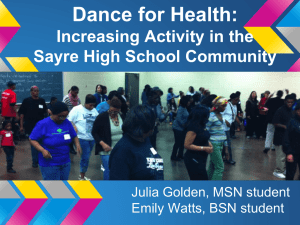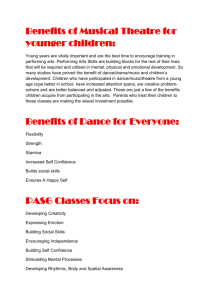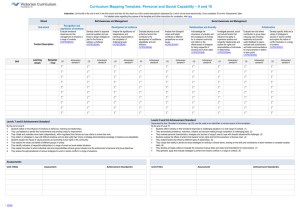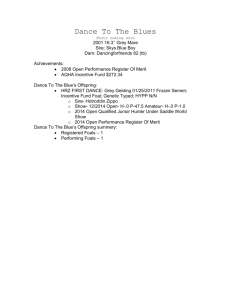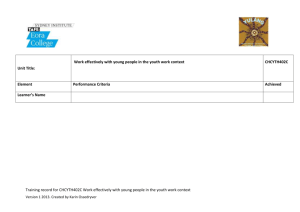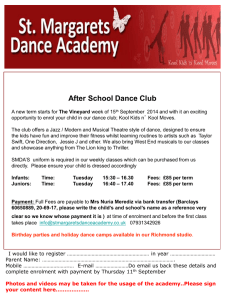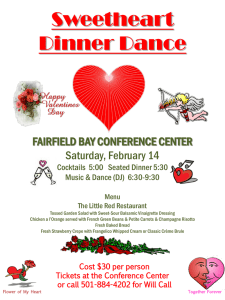Dance
advertisement
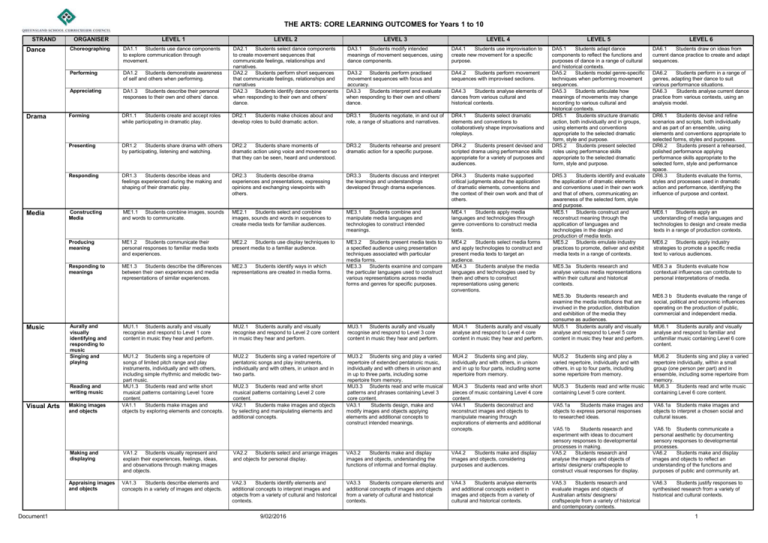
THE ARTS: CORE LEARNING OUTCOMES for Years 1 to 10 STRAND Dance Drama Media Music ORGANISER LEVEL 2 LEVEL 3 LEVEL 4 LEVEL 5 LEVEL 6 DA2.1 Students select dance components to create movement sequences that communicate feelings, relationships and narratives. DA2.2 Students perform short sequences that communicate feelings, relationships and narratives DA2.3 Students identify dance components when responding to their own and others’ dance. DA3.1 Students modify intended meanings of movement sequences, using dance components. DA4.1 Students use improvisation to create new movement for a specific purpose. DA6.1 Students draw on ideas from current dance practice to create and adapt sequences. DA3.2 Students perform practised movement sequences with focus and accuracy. DA3.3 Students interpret and evaluate when responding to their own and others’ dance. DA4.2 Students perform movement sequences with improvised sections. DR1.1 Students create and accept roles while participating in dramatic play. DR2.1 Students make choices about and develop roles to build dramatic action. DR3.1 Students negotiate, in and out of role, a range of situations and narratives. DR4.1 Students select dramatic elements and conventions to collaboratively shape improvisations and roleplays. Presenting DR1.2 Students share drama with others by participating, listening and watching. DR2.2 Students share moments of dramatic action using voice and movement so that they can be seen, heard and understood. DR3.2 Students rehearse and present dramatic action for a specific purpose. DR4.2 Students present devised and scripted drama using performance skills appropriate for a variety of purposes and audiences. DA5.1 Students adapt dance components to reflect the functions and purposes of dance in a range of cultural and historical contexts. DA5.2 Students model genre-specific techniques when performing movement sequences. DA5.3 Students articulate how meanings of movements may change according to various cultural and historical contexts. DR5.1 Students structure dramatic action, both individually and in groups, using elements and conventions appropriate to the selected dramatic form, style and purpose. DR5.2 Students present selected roles using performance skills appropriate to the selected dramatic form, style and purpose. Responding DR1.3 Students describe ideas and feelings experienced during the making and shaping of their dramatic play. DR2.3 Students describe drama experiences and presentations, expressing opinions and exchanging viewpoints with others. DR3.3 Students discuss and interpret the learnings and understandings developed through drama experiences. DR4.3 Students make supported critical judgments about the application of dramatic elements, conventions and the context of their own work and that of others. Constructing Media ME1.1 Students combine images, sounds and words to communicate. ME2.1 Students select and combine images, sounds and words in sequences to create media texts for familiar audiences. ME3.1 Students combine and manipulate media languages and technologies to construct intended meanings. ME4.1 Students apply media languages and technologies through genre conventions to construct media texts. Producing meaning ME1.2 Students communicate their personal responses to familiar media texts and experiences. ME2.2 Students use display techniques to present media to a familiar audience. Responding to meanings ME1.3 Students describe the differences between their own experiences and media representations of similar experiences. ME2.3 Students identify ways in which representations are created in media forms. ME3.2 Students present media texts to a specified audience using presentation techniques associated with particular media forms. ME3.3 Students examine and compare the particular languages used to construct various representations across media forms and genres for specific purposes. ME4.2 Students select media forms and apply technologies to construct and present media texts to target an audience. ME4.3 Students analyse the media languages and technologies used by them and others to construct representations using generic conventions. DA1.1 Students use dance components to explore communication through movement. Performing DA1.2 Students demonstrate awareness of self and others when performing. Appreciating DA1.3 Students describe their personal responses to their own and others’ dance. Forming Aurally and visually identifying and responding to music Singing and playing Reading and writing music Visual Arts Document1 LEVEL 1 Choreographing Making images and objects DA4.3 Students analyse elements of dances from various cultural and historical contexts. DR5.3 Students identify and evaluate the application of dramatic elements and conventions used in their own work and that of others, communicating an awareness of the selected form, style and purpose. ME5.1 Students construct and reconstruct meaning through the application of languages and technologies in the design and production of media texts. ME5.2 Students emulate industry practices to promote, deliver and exhibit media texts in a range of contexts. DA6.2 Students perform in a range of genres, adapting their dance to suit various performance situations. DA6.3 Students analyse current dance practice from various contexts, using an analysis model. DR6.1 Students devise and refine scenarios and scripts, both individually and as part of an ensemble, using elements and conventions appropriate to selected forms, styles and purposes. DR6.2 Students present a rehearsed, polished performance applying performance skills appropriate to the selected form, style and performance space. DR6.3 Students evaluate the forms, styles and processes used in dramatic action and performance, identifying the influence of purpose and context. ME6.1 Students apply an understanding of media languages and technologies to design and create media texts in a range of production contexts. ME6.2 Students apply industry strategies to promote a specific media text to various audiences. ME5.3a Students research and analyse various media representations within their cultural and historical contexts. ME6.3 a Students evaluate how contextual influences can contribute to personal interpretations of media. ME6.3 b Students evaluate the range of social, political and economic influences operating on the production of public, commercial and independent media. MU1.1 Students aurally and visually recognise and respond to Level 1 core content in music they hear and perform. MU2.1 Students aurally and visually recognise and respond to Level 2 core content in music they hear and perform. MU3.1 Students aurally and visually recognise and respond to Level 3 core content in music they hear and perform. MU4.1 Students aurally and visually analyse and respond to Level 4 core content in music they hear and perform. ME5.3b Students research and examine the media institutions that are involved in the production, distribution and exhibition of the media they consume as audiences. MU5.1 Students aurally and visually analyse and respond to Level 5 core content in music they hear and perform. MU1.2 Students sing a repertoire of songs of limited pitch range and play instruments, individually and with others, including simple rhythmic and melodic twopart music. MU1.3 Students read and write short musical patterns containing Level 1core content. VA1.1 Students make images and objects by exploring elements and concepts. MU2.2 Students sing a varied repertoire of pentatonic songs and play instruments, individually and with others, in unison and in two parts. MU3.2 Students sing and play a varied repertoire of extended pentatonic music, individually and with others in unison and in up to three parts, including some repertoire from memory. MU3.3 Students read and write musical patterns and phrases containing Level 3 core content. VA3.1 Students design, make and modify images and objects applying elements and additional concepts to construct intended meanings. MU4.2 Students sing and play, individually and with others, in unison and in up to four parts, including some repertoire from memory. MU5.2 Students sing and play a varied repertoire, individually and with others, in up to four parts, including some repertoire from memory. MU4.3 Students read and write short pieces of music containing Level 4 core content. VA4.1 Students deconstruct and reconstruct images and objects to manipulate meaning through explorations of elements and additional concepts. MU5.3 Students read and write music containing Level 5 core content. MU6.2 Students sing and play a varied repertoire individually, within a small group (one person per part) and in ensemble, including some repertoire from memory. MU6.3 Students read and write music containing Level 6 core content. VA5.1a Students make images and objects to express personal responses to researched ideas. VA6.1a Students make images and objects to interpret a chosen social and cultural issues. VA5.1b Students research and experiment with ideas to document sensory responses to developmental processes in making. VA5.2 Students research and analyse the images and objects of artists/ designers/ craftspeople to construct visual responses for display. VA6.1b Students communicate a personal aesthetic by documenting sensory responses to developmental processes. VA6.2 Students make and display images and objects to reflect an understanding of the functions and purposes of public and community art. VA5.3 Students research and evaluate images and objects of Australian artists/ designers/ craftspeople from a variety of historical and contemporary contexts. VA6.3 Students justify responses to synthesised research from a variety of historical and cultural contexts. MU2.3 Students read and write short musical patterns containing Level 2 core content. VA2.1 Students make images and objects by selecting and manipulating elements and additional concepts. Making and displaying VA1.2 Students visually represent and explain their experiences, feelings, ideas, and observations through making images and objects. VA2.2 Students select and arrange images and objects for personal display. VA3.2 Students make and display images and objects, understanding the functions of informal and formal display. VA4.2 Students make and display images and objects, considering purposes and audiences. Appraising images and objects VA1.3 Students describe elements and concepts in a variety of images and objects. VA2.3 Students identify elements and additional concepts to interpret images and objects from a variety of cultural and historical contexts. VA3.3 Students compare elements and additional concepts of images and objects from a variety of cultural and historical contexts. VA4.3 Students analyse elements and additional concepts evident in images and objects from a variety of cultural and historical contexts. 9/02/2016 MU6.1 Students aurally and visually analyse and respond to familiar and unfamiliar music containing Level 6 core content. 1 Document1 9/02/2016 2
